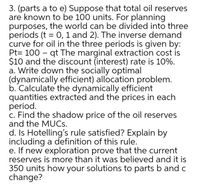3. (parts a to e) Suppose that total oil reserves are known to be 100 units. For planning purposes, the world can be divided into three periods (t = 0, 1 and 2). The inverse demand curve for oil in the three periods is given by: Pt= 100 – qt The marginal extraction cost is $10 and the discount (interest) rate is 10%. a. Write down the socially optimal (dynamically efficient) allocation problem. b. Calculate the dynamically efficient quantities extracted and the prices in each period. c. Find the shadow price of the oil reserves and the MUCS. d. Is Hotelling's rule satisfied? Explain by including a definition of this rule. e. If new exploration prove that the current reserves is more than it was believed and it is 350 units how your solutions to parts b and c change?
3. (parts a to e) Suppose that total oil reserves are known to be 100 units. For planning purposes, the world can be divided into three periods (t = 0, 1 and 2). The inverse demand curve for oil in the three periods is given by: Pt= 100 – qt The marginal extraction cost is $10 and the discount (interest) rate is 10%. a. Write down the socially optimal (dynamically efficient) allocation problem. b. Calculate the dynamically efficient quantities extracted and the prices in each period. c. Find the shadow price of the oil reserves and the MUCS. d. Is Hotelling's rule satisfied? Explain by including a definition of this rule. e. If new exploration prove that the current reserves is more than it was believed and it is 350 units how your solutions to parts b and c change?
Oh no! Our experts couldn't answer your question.
Don't worry! We won't leave you hanging. Plus, we're giving you back one question for the inconvenience.
Submit your question and receive a step-by-step explanation from our experts in as fast as 30 minutes.
You have no more questions left.
Message from our expert:
Hi and thanks for your question! Unfortunately we cannot answer this particular question due to its complexity.
We've credited a question back to your account. Apologies for the inconvenience.
Your Question:

Transcribed Image Text:3. (parts a to e) Suppose that total oil reserves
are known to be 100 units. For planning
purposes, the world can be divided into three
periods (t = 0, 1 and 2). The inverse demand
curve for oil in the three periods is given by:
Pt= 100 – qt The marginal extraction cost is
$10 and the discount (interest) rate is 10%.
a. Write down the socially optimal
(dynamically efficient) allocation problem.
b. Calculate the dynamically efficient
quantities extracted and the prices in each
period.
c. Find the shadow price of the oil reserves
and the MUCS.
d. Is Hotelling's rule satisfied? Explain by
including a definition of this rule.
e. If new exploration prove that the current
reserves is more than it was believed and it is
350 units how your solutions to parts b and c
change?
Recommended textbooks for you


Principles of Economics (12th Edition)
Economics
ISBN:
9780134078779
Author:
Karl E. Case, Ray C. Fair, Sharon E. Oster
Publisher:
PEARSON

Engineering Economy (17th Edition)
Economics
ISBN:
9780134870069
Author:
William G. Sullivan, Elin M. Wicks, C. Patrick Koelling
Publisher:
PEARSON


Principles of Economics (12th Edition)
Economics
ISBN:
9780134078779
Author:
Karl E. Case, Ray C. Fair, Sharon E. Oster
Publisher:
PEARSON

Engineering Economy (17th Edition)
Economics
ISBN:
9780134870069
Author:
William G. Sullivan, Elin M. Wicks, C. Patrick Koelling
Publisher:
PEARSON

Principles of Economics (MindTap Course List)
Economics
ISBN:
9781305585126
Author:
N. Gregory Mankiw
Publisher:
Cengage Learning

Managerial Economics: A Problem Solving Approach
Economics
ISBN:
9781337106665
Author:
Luke M. Froeb, Brian T. McCann, Michael R. Ward, Mike Shor
Publisher:
Cengage Learning

Managerial Economics & Business Strategy (Mcgraw-…
Economics
ISBN:
9781259290619
Author:
Michael Baye, Jeff Prince
Publisher:
McGraw-Hill Education
